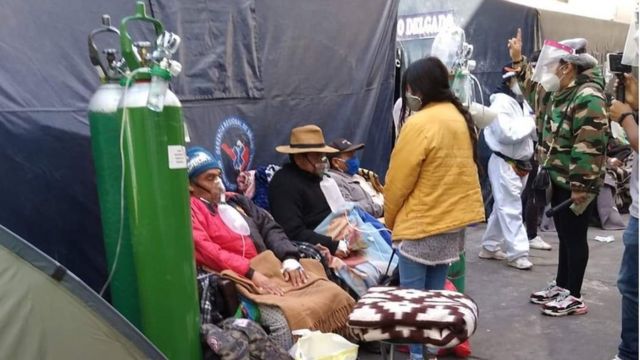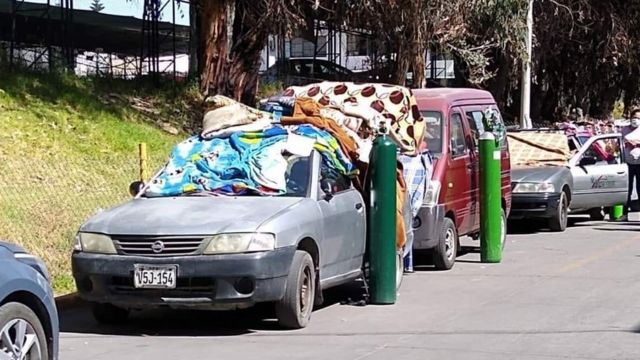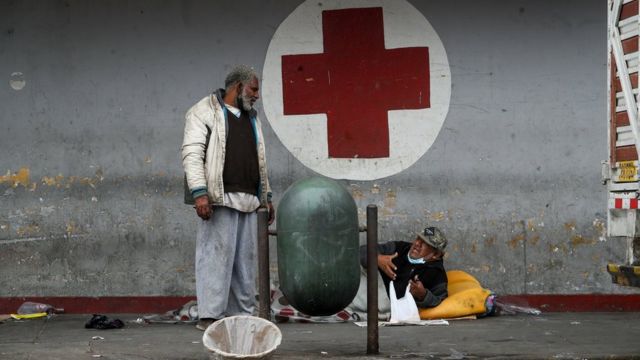Desperate families spend hours searching for oxygen in a parallel market in Peru
Queues to refuel oxygen balloons in Lima, the Peruvian capital
The new coronavirus pandemic revealed that Peruvian public hospitals do not have enough storage of a basic product for life: oxygen.
The scarcity of the input shows that, despite consecutive years of economic growth and a drop in poverty rates, the Andean country neighboring Brazil has not invested in its health sector. With the increase in cases of covid-19, family members of patients with the disease have to face hours in lines in the streets of the capital Lima, Arequipa, birthplace of writer Mario Vargas Llosa, and Huancayo, in the mountains, among other places, to get the vital chemical element.
Since the number of cases rose in the national territory, at least two months ago, family members spend hours in lines, often on the parallel market, to supply heavy pipes, which are more than one meter high. From there, from the queues, they go home or to the hospital doors, where their sick relatives are waiting to be helped. There are cases in which they take the tubes directly to hospitals, where the family member is hospitalized and there is no input.
The scarcity of the product caused the skyrocket in prices. To the local press, the families of those suffering from covid-19 told that they even sold personal items to pay, last month, 4,500 soles, almost US$ 1,300, to parallel oxygen sellers - and without knowing the origin of the merchandise.
A few days ago, businessman Mario Romero, who was named "Oxígeno Angel" because he sold the input at low prices, died of Covid-19 and caused a commotion in the country. "Rest in peace, angel of oxygen," lamented the Peruvians on social networks.
People line up in the street with their own oxygen balloons in Arequipa
The scarcity situation has led religious to campaign for the urgent installation of oxygen factories in the country, as reported, for example, on the Caritas website in Huancayo. Health Minister Víctor Zamora said that, in normal times, oxygen consumption was equivalent to 60 tons a day. With the pandemic, this was multiplied by five, reaching 290 tons a day.
Indigenous Scourge
But in addition to the lack of oxygen, the country faces, in this pandemic, obstacles similar to those in other countries with indigenous peoples. In the Peruvian case, the indigenous peoples registered the first cases of coronaviruses, in April and last May, with fatal victims, awakening appeals from the leaders of the indigenous peoples for greater medical attention.
Peruvians also suffer from other problems, such as the lack of health professionals trained in the proper use of equipment for the treatment of coronavirus. In addition, covid-19 patients sleep in camp tents, in the cold, at the entrance of hospitals in Arequipa, the country's second largest city, or line up with cars, with their own oxygen tubes, waiting to be seen.
This is what happens, for example, at the Hospital Honorio Delgado, on the spot. According to international news agencies, in Arequipa the 'botellón' (tube) of oxygen costs around 1,600 dollars - expensive for many people in the city that is rich in mining.
People line up in the street with their own oxygen balloons in Arequipa
Last week, President Martín Vizcarra was in Arequipa and was received by protests from health personnel. The image of a woman, Celia Capira, in tears, running after the presidential delegation, asking for a bed for her covid-19-sick husband, went viral. The 57-year-old husband was camped outside the Hospital Honorio Delgado and died hours later.
"I apologize for not listening," the president said publicly. The woman, a mother of three, said she didn't want an apology, but wanted the government to take care of the Peruvians.
"The Peruvian health problem is not limited to the lack of beds and investments, but it is one of incompetence. In Arequipa, there are places with beds, but there are also, due to poor management of the pandemic, people who sleep in the tents, waiting for care," he said to BBC News Brasil the professor at the National University of San Marcos, Carlos Aquino.
With more than 370 thousand cases of the disease, according to data from the Johns Hopkins University, in the United States, Peru is the country with the most infected in South America after Brazil. On Tuesday night (28), the country registered 18,418 deaths - almost double the number of deaths in Chile and about six times more than the total number of deaths in Argentina, according to the American institution.
People who live on the street, just a few steps from one of the main hospitals in the country, in La Victoria, near the presidential palace
"Money is not the problem"
Last week, the Medical College of Peru issued a statement asking the government to distribute adequate protective equipment for health teams. In the statement, it is stated that 91 doctors died, victims of covid-19, another 2,655 were infected and 76 of them are in ICUs.
"It is very sad to see the country, which is not poor, which has cash in cash, living in this situation. Peru has reserves at the Central Bank, has organized accounts and could have access, if needed, to an IMF credit for emergency ", said Carlos Aquino.
With about 32 million inhabitants, the Andean country has registered strong and continuous economic growth over the last 20 years, as a result of its mineral and fruit exports and tourism. The economic expansion was accompanied, for most of this period, by the reduction in poverty, which went from 58.7% in 2004 to 20% in 2019, according to official data.
But its high rate of informal workers - around 70% - has complicated the possibility of respecting the quarantine, which began in March, as many live off the money earned in their daily lives. The fact that many work and shop in the country's food markets has also allowed the virus to spread, according to experts. Poverty is expected to rise this year and the economy to fall 13.9%, according to projections by the International Monetary Fund (IMF).
"Due to its quarantine, which is longer than expected and due to lower external demand, the Peruvian economy is expected to fall 13.9%," said Alejandro Werner, director of the organization's Western Hemisphere Department. "It will be one of the biggest economic downturns in the world. The quarantine lasted three months and two weeks. But it didn't work because the vast majority are informal workers and, in addition, it was not enough to control the spread of the coronavirus," Aquino said.
The Peruvian quarantine, which began on March 16, was suspended on June 30.
Economic decay and social setback - with the expectation, as in other countries in the region, of a sharp increase in poverty - had not been detected in the country in other recent crises. The performance of the economy, which registered expansions above 5%, was practically unaffected during local investigations by Lava Jato, involving four former presidents.
Amid the investigations, Alan García, who governed the country twice (1985-1990 and 2006-2011), committed suicide last year. Pedro Pablo Kuczynski (2016-2018) has resigned as President and is under house arrest. Ollanta Humala (2011-2016) spent months in prison. Because of the risk of contracting coronaviruses, as his defense argued, Alejandro Toledo, 74, who ruled the country between 2001 and 2006, paid bail and since March has been under house arrest in the United States, where he lives.




No comments:
Post a Comment